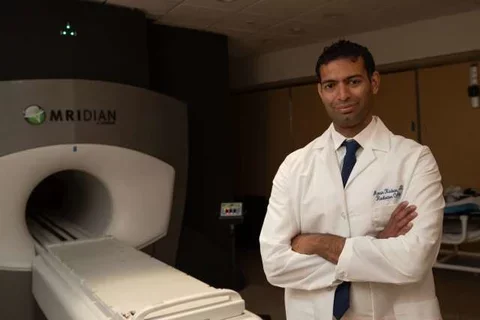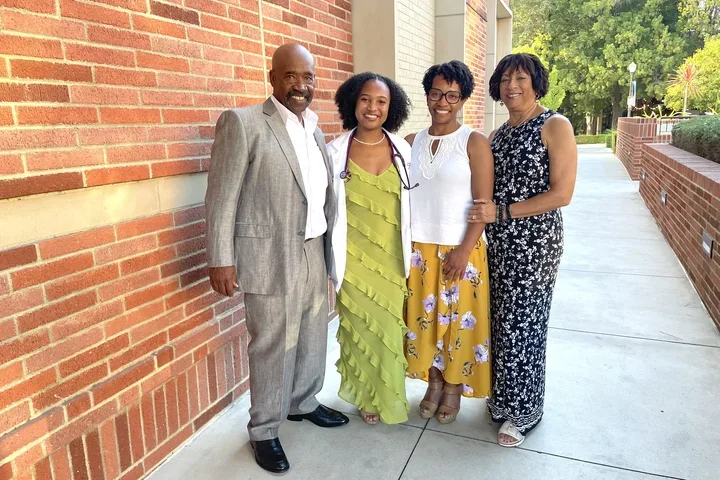Quality-of-Life Outcomes and Toxicity Among Patients Treated with Novel Short Course Radiation Therapy for Recurrent Prostate Cancer after Prostatectomy
UCLA Jonsson Comprehensive Cancer Center-led Study

UCLA Research Brief
UCLA Jonsson Comprehensive Cancer Center-led study looks at quality-of-life outcomes and toxicity among patients treated with novel short course radiation therapy for recurrent prostate cancer after prostatectomy
PURPOSE
This study was designed to evaluate the use of stereotactic body radiation therapy (SBRT) to treat patients with localized prostate cancer following radical prostatectomy, based on short-term physician-scored genitourinary (GU) and gastrointestinal (GI) toxicities and patient-reported quality-of-life (QOL) outcomes. The therapy was administered with either CT (CTgRT) or MRI (MRgRT) guidance.
FINDINGS
Acute and late grade 2 GU toxicities were both 9%, while acute and late grade 2 GI toxicities were 5% and 0%. Three patients had grade 3 toxicity (1 GU and 2 GI). No patients receiving MRgRT had grade 3 GU or GI toxicity above grade 2.
A secondary analysis compared CT- and MRI-guided therapy administration. MRgRT was associated with a 30-percent reduction in any grade acute GI toxicity. Additionally, MRgRT was independently associated with less GI toxicity overall and improved bowel QOL outcomes.
This study appears in the International Journal of Radiation Oncology-Biology-Physics.
CONCLUSIONS
The authors report that SBRT to treat localized prostate cancer after radical prostatectomy was well tolerated up to six months, based on both physician-scored toxicity and patient-reported outcomes. MRI-guided radiation therapy had significantly less GI toxicity and better-preserved bowel function compared with CT guidance. Longer-term follow-up and randomized trials are needed to further evaluate the safety and effectiveness of SBRT use in this patient population. Given the favorable outcomes of the SCIMITAR trial, UCLA is currently offering MRI-guided SBRT for patients with a recurrence after radical prostatectomy on the ongoing EXCALIBUR trial.
BACKGROUND
Prostate cancer is the second most common cancer in American men – after skin cancer – and one in eight men will be diagnosed with it during their lifetimes, according to the American Cancer Society. In 2022, there will be more than 268,000 new cases and almost 35,000 deaths from the disease.
Prostatectomy or surgery to remove all or part of the prostate is a common treatment for localized prostate cancer. However, up to one-third of patients will experience some recurrence of their cancer within 10 years of their prostatectomy.
Postoperative radiation is an underutilized standard of care for prostate cancer patients with recurrence after radical prostatectomy. Stereotactic body radiation therapy is a well-studied and convenient option for most patients, but data on its use among post-prostatectomy patients was extremely limited.
METHODS
This single-arm, dual-center, phase II trial was conducted at UCLA’s Jonsson Comprehensive Cancer Center and the University of Southern California, where postoperative prostate cancer patients with prostate-specific antigen (PSA) scores above 0.03 ng/ml or adverse pathology were enrolled from February 2018 to March 2021.
The study included 100 participants, with 69 of them receiving SBRT via CTgRT and 31 receiving MRgRT in a non-randomized fashion. Median follow-up was 29.5 months (CTgRT: 33.3, MRgRT: 22.6 months).
Physician-scored toxicities and patient-reported QOL outcomes were collected at baseline and one-, three- and six-month follow-up intervals.
Univariable and multivariable analyses were performed to evaluate predictors of toxicities and QOL outcomes.
EXPERT COMMENTS
“While it should still only be done on a clinical trial, the early results of the SCIMITAR protocol are very promising for SBRT in the context of a patient needing post-prostatectomy radiation,” said Amar Kishan, MD, of the UCLA Jonsson Comprehensive Cancer Center, the study’s corresponding and co-senior author.
“Additionally, the use of MRI guidance appears to improve SBRT precision when compared with CT-guided therapy, resulting in less overall toxicity and better-preserved quality-of-life outcomes for patients,” he added.
The authors noted that randomized trials featuring longer follow-up periods are needed to further evaluate SBRT’s safety and effectiveness in treating localized prostate cancer after prostatectomy.
“This finding, as well as the overall promising early results of SCIMITAR, is why we have opened the EXCALIBUR study, on which we are exclusively using MRI-guidance to deliver post-prostatectomy SBRT to a broader group of patients,” said Dr. Ting Martin Ma, chief radiation oncology resident at UCLA Jonsson Comprehensive Cancer Center and first author on the article.
OTHER AUTHORS
Co-senior author Minsong Cao is a Radiation Oncology researcher at UCLA. Ting Martin Ma, the first author, is a Chief Resident at UCLA. Leslie K. Ballas is a Radiation Oncology physician-researcher at USC. Holly Wilhalme, the author responsible for statistical analysis, is with the Department of Medicine Statistics Core at UCLA. Ankush Sachdeva, Natalie Chong, Sahil Sharma, Tiffany Yang, Vincent Basehart, Nicholas G. Nickols, Stephanie M. Yoon, Lauren Smith, Yu Gao and Michael L. Steinberg are Radiation Oncology researchers at UCLA. Robert E. Reiter, Christopher Saigal, Karim Chamie, Mark S. Litwin and Matthew B. Rettig are UCLA Department of Urology physician-researchers. Litwin also has affiliations with the UCLA Fielding School of Public Health and UCLA School of Nursing.
FUNDING
The trial was partially funded by ViewRay, Inc.
POTENTIAL CONFLICT STATEMENT
Kishan reports funding support from grant P50CA09213 from the Prostate Cancer National Institutes of Health Specialized Programs of Research Excellence and grant W81XWH-22-1-0044 from the Department of Defense, as well as grant RSD1836 from the Radiological Society of North America. Additional funding sources include the STOP Cancer organization, Jonsson Comprehensive Cancer Center and Prostate Cancer Foundation. He also reports research support related to this study, and consulting fees, from ViewRay, Inc., and discloses low-value stock held in ViewRay, Inc. All other authors have no conflicts of interest to declare.
Study: Quality-of-Life Outcomes and Toxicity Profile Among Patients with Localized Prostate Cancer After Radical Prostatectomy Treated With Stereotactic Body Radiation: The SCIMITAR Multi-Center Phase 2 Trial DOI: 10.1016/j.ijrobp.2022.08.041.



